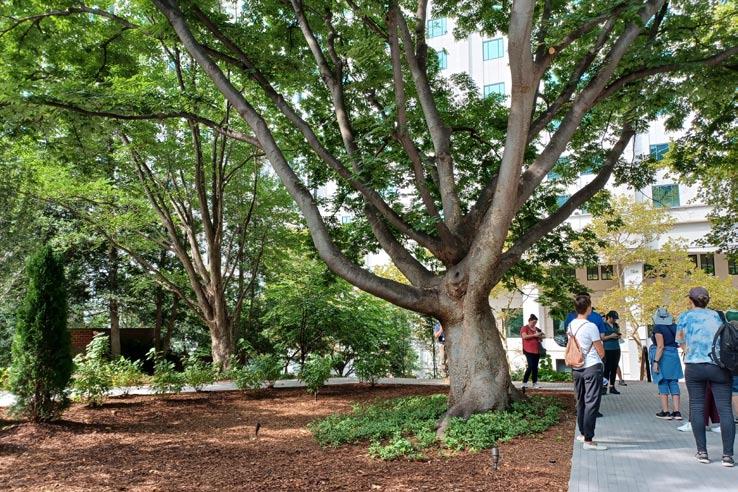
3 minute read
LOCALnews
Urban Tree Summit 2021
By Charlotte Benedetto
More and more, people want their cities green! Urban parks and shade trees are powerful quality-of-life criteria. Urban green spaces are integral for cities to develop the resilience to survive complex socio-political challenges and adapt to climate reality. In bringing together voices in urban tree management, urban ecology, and urban arboriculture, the recent Urban Tree Summit of 2021 was green, inspiring, and informational. Seminars, field sessions, and online events orchestrated by Montgomery Parks and Casey Trees of Washington, DC, came together in well-planned educational series. The Summit’s curriculum framework is relevant for urban homeowners, designers, planners, and all horticulturists as they cope with, and attempt to mitigate, ecological and climate anxiety. Focused on installation and maintenance of trees in the urban landscape, all too often installed in mere apertures in the concrete, and often subject to high environmental stress, the Urban Tree Summit reviewed the micro and macro effects and benefits of urban forests on the surrounding environment. Fungi, often overlooked but utterly indispensable organisms in the urban forest, were the subject of a seminar by Kevin Smith, supervisory plant pathologist with the U.S. Forest Service. The standards for tree pits and bioretention plantings were extensively covered during boots-on-the-ground Field Sessions. Vincent Verweij, arborist and urban forestry manager with the Arlington Department of Parks and Recreation, led a brisk, informational hike and assessment in the urban hills near Hillside Park. A live sawmill demonstration for city managers looking to maximize their urban timber and reduce waste was one aromatic highlight, with the details handled by Partick Harwood, urban forester with Montgomery Parks, and Shaun Preston, recycling coordinator from Camp Small in Baltimore. Wood chipping and recycling is an invaluable way to sequester carbon and improve urban soils. The highly technical aspects of managing of urban trees involve both hard science and hard technique. The summit covered discussions of urban forest diversity, as well as the latest findings in ecological research, via Zoom meetings with experts such as biology researcher Carly Ziter from Concordia University, Montreal. One Field Session integrated a pop-up arboretum in Langdon Park, with Dr. Earl Eutseler, a forester with DC’s DDOT Urban Forestry Division, covering the science of plant-identification and urban tree assessments. Hard-to-find information about green roofs and tree pits was covered in the Rosslyn Field Session with Vincent Verweij, local arborist and urban forestry manager. Even the role of fungi in urban and community greenspaces was included in this wide-ranging ecological forum. Tree pits, the soil-filled apertures in concrete sidewalk areas, are often the only trees urbanites have access to. Fortunately, the art and science of these urban tree settings have come a long way since the days of sloping, always-cracked sidewalks and ancient, hammered-in iron banding. Tree pits now incorporate underground soil chambers to allow roots to spread under the sidewalk—sparing infrastructure and reducing economic and maintenance pressure. Pits must meet rigorous community standards and biologically appropriate soil volumes, “Our current standards are at least four feet wide and about 600–1200 cubic feet depending on the species and the availability of size,” said Verweij, who led the Field Session on Tree Pits and Green Roofs. The bio-retention pits often installed in urban situations are a fashionable example of integrating a desire for aesthetic, green spaces with the economic and logistical challenges of climate change. Managing stormwater runoff in a highly developed urban milieu is a compelling priority, but do bio-retention plantings really work? The technology is still evolving. Bioretention and urban canopy trees may ultimately be a somewhat-mediocre marriage: “Engineers are not used to something that improves over time, like a tree. And they don’t build for it,” said Verweij. Bio-retention plantings are highly regulated, “It might be a perfectly healthy tree, but if the bio-rentention tree pit fails, they would be required to replace that...you’re removing a healthy tree? That’s doing just fine? Because of this regulatory requirement? I’m not looking forward to that conversation.” A rewarding and in-depth exploration of the connections between human beings to the urban tree and its benefits, the Urban Tree Summit but viewed with respect to the criteria required in the current policy-driven reality. Any horticulturist committed to a green future would do well to attend in 2022. o
Charlotte Benedetto is a writer, artist, and gardener living in Great Falls, VA. She is enrolled in the Northern Virginia Community College horticulture program and is an intern this fall with Washington Gardener.









